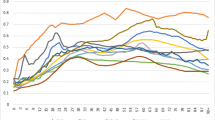Abstract
This paper reexamines the problem of the relationship between demographic growth and per capita income in neo-classical growth models with age-structured populations. It is suggested that, when they assume a constant rate of capital depreciation, such models overestimate the negative impact of population growth through capital dilution effects. With more realistic depreciation schedules, the ageing of the capital stock which results from lower growth implies a higher overall depreciation rate, which reduces benefits from lower capital dilution. The implications of this observation are examined for the existence of an optimum population growth rate, for models with heterogeneous capital, and for models where capital obsolescence is not fixed but is allowed to vary.
Similar content being viewed by others
References
Arthur WB, McNicoll G (1977) Optimal time paths with age-dependence: a theory of population policy. Rev Econ Stud 44:111–123
Arthur WB, McNicoll G (1978) Samuelson, population and intergenerational transfers. Int Econ Rev 19:241–246
Deardoff AV (1976) The growth rate for population: comment. Int Econ Rev 17:510–515
Hahn FH (1966) Equilibrium dynamics with heterogenous capital goods. Q J Econ 80:633–646
Kuga K (1977) General saddlepoint property of the steady state of a growth model with heterogenous capital goods. Int Econ Rev 18:29–58
Lee RD (1980) Age structure, intergenerational transfers and economic growth: an overview. Rev Econ (Paris) 6:1129–1156
Lee RD, Lapkoff S (1988) Intergenerational flows of time and goods over the life cycle: consequences of slowing population growth. J Polit Econ 96:618–651
Samuelson PA (1975) The optimum growth rate of a population. Int Econ Rev 16:531–538
Willis RJ (1982) The direction of intergenerational transfers and demographic transition: the Caldwell hypothesis reexamined. In: Ben Porath Y (ed) Income distribution and the family. Supplement to Popul Dev Rev 207–234
Author information
Authors and Affiliations
Additional information
This article is a modified version of a paper presented at the First Annual Meeting of the European Society for Population Economics, Rotterdam, September 1987. I am indebted to the anonymous referees for helpful comments and suggestions and to Linda Sergent for revising the English text.
Rights and permissions
About this article
Cite this article
Blanchet, D. Age structure and capital dilution effects in neo-classical growth models. J Popul Econ 1, 183–194 (1989). https://doi.org/10.1007/BF00161477
Received:
Accepted:
Issue Date:
DOI: https://doi.org/10.1007/BF00161477




